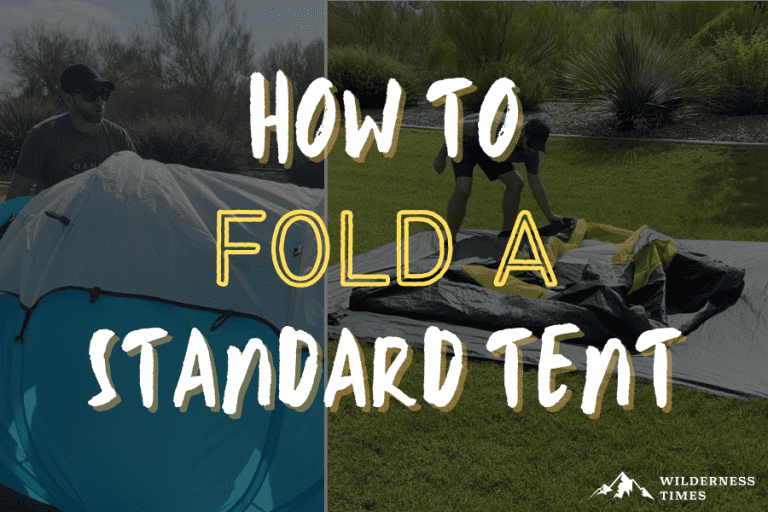Tents are a vital part of every campout. But not everyone knows how to fold a tent properly.
When the camping is all said and done and it’s time to pack up the tent, things can get confusing.
In this article, we’ll review how to fold standard tents, so you’ll be a pro by your next campout.
Table of Contents
ToggleHow To Fold A Tent
Most standard tents – including dome, A-frame, tunnel, and cabin – follow a similar folding and packing process.
And some tents can vary on their folding needs depending on number of doors, guylines, rain flies, etc. But here are the basic steps you need to know to fold a standard tent!
Step 1: Lay The Tent Flat
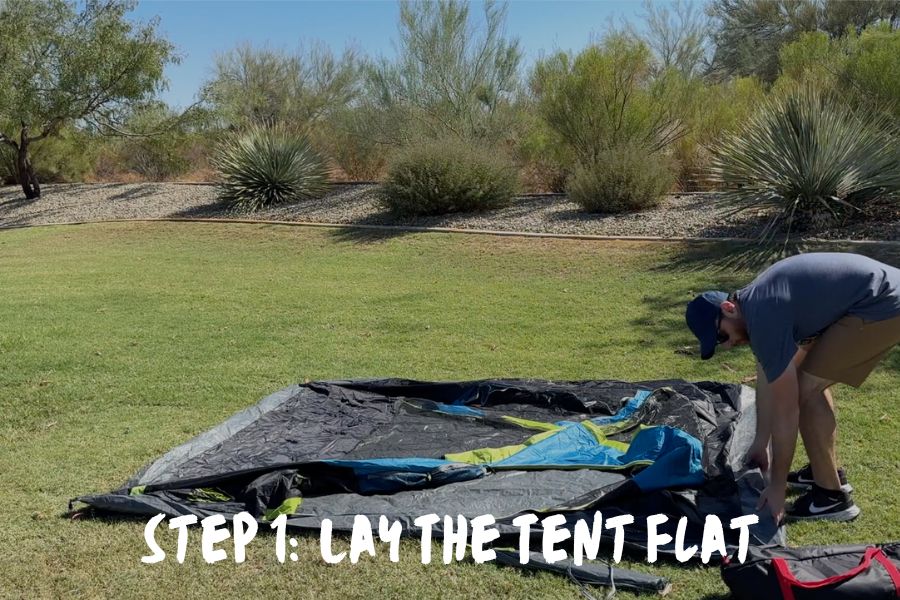
Once you have taken your tent down, do your best to lay the tent as flat as possible.
Part of this step also includes ensuring that there is nothing left inside the tent.
It’s easy to forget headlamps and other small pieces of gear in the pockets on the side of the tent.
By checking at this step, you’ll make sure your packed tent doesn’t take on any extra weight – and that you don’t lose your gear.
Once your tent has been emptied and laid flat, it’s time to move on to the next step.
Step 2: Remove Tent Poles
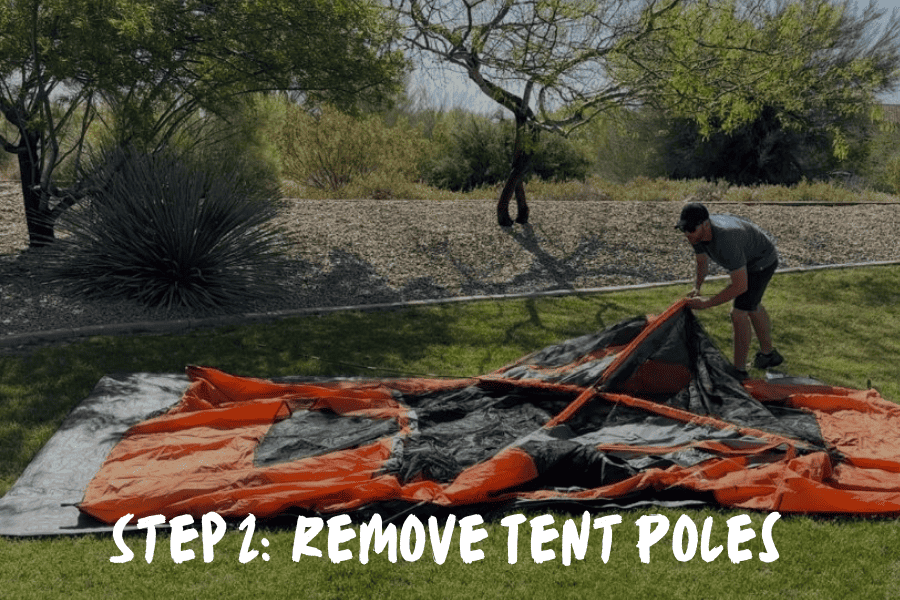
Make sure all of the poles and stakes have been removed from the tent.
For some tents, this will be easier to do before lying the tent flat on the ground.
But now is the last chance you have to take those poles out. If you forget, you won’t be able to fold the tent properly.
And you should NEVER store your tent with the poles still intact!
Step 3: Remove All The Air & Flatten It Out
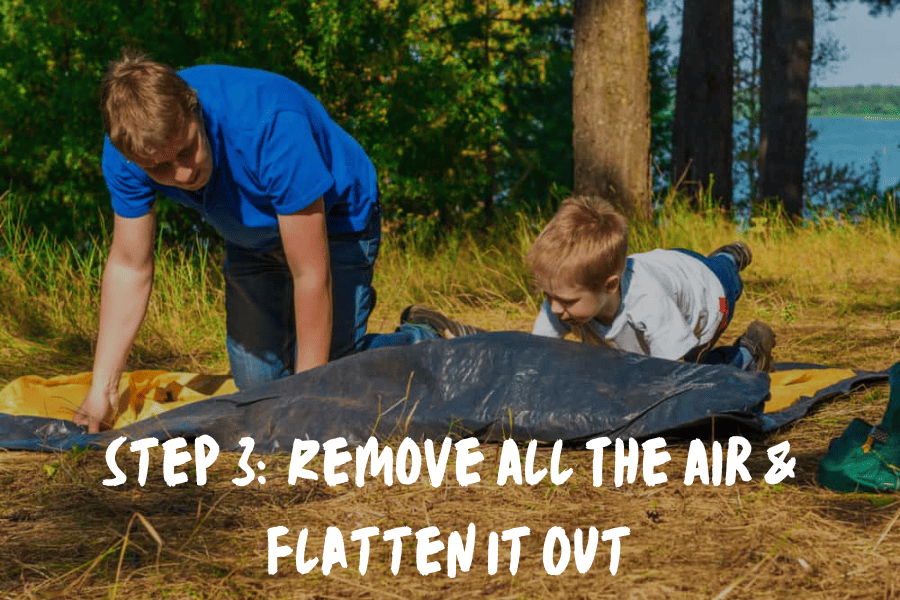
Next, do your best to press down and remove any excess air that might still be caught in the tent fabric.
During this step, it’s important to get the bulk air pockets out because it’ll make the tent easier to fold.
Even after you complete this action, there will likely still be air caught in the tent.
Never fear! You will get rid of the remainder of the air when you fully fold the tent.
Step 4: Fold The Tent Lengthwise
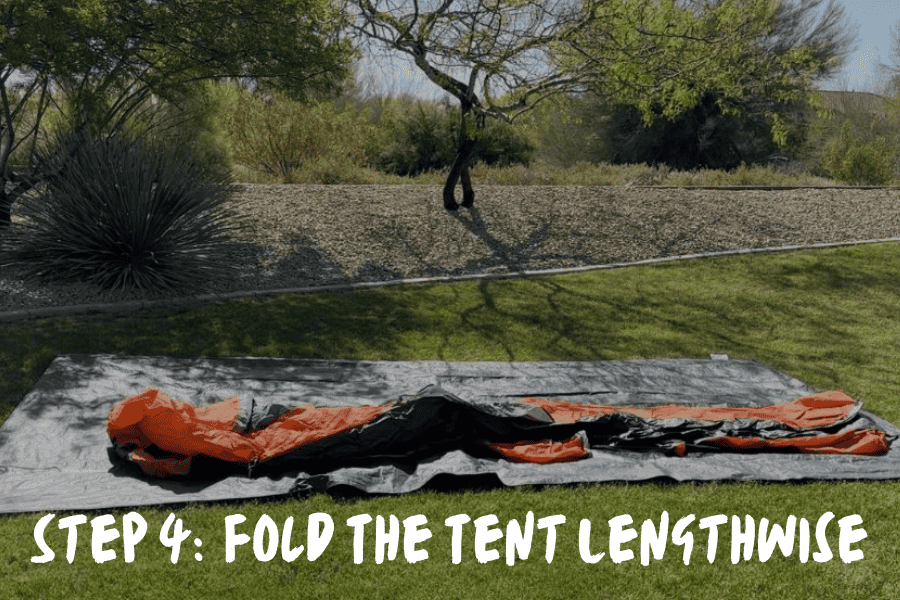
With the majority of the air pressed out of the tent, fold the sides towards the middle of the tent so that the tent fabric is consolidated into one long strip of fabric.
The goal of this step is to have everything aligned so when you roll the tent, all the fabric is included in the roll.
The best rule of thumb is to fold the tent lengthwise until the strip is the same width as the carry bag (maybe even smaller).
It’s fine to have areas of the long strip that have more fabric in some spots than in others – that will even out when you roll the tent up.
Step 5: Roll/Fold The Tent
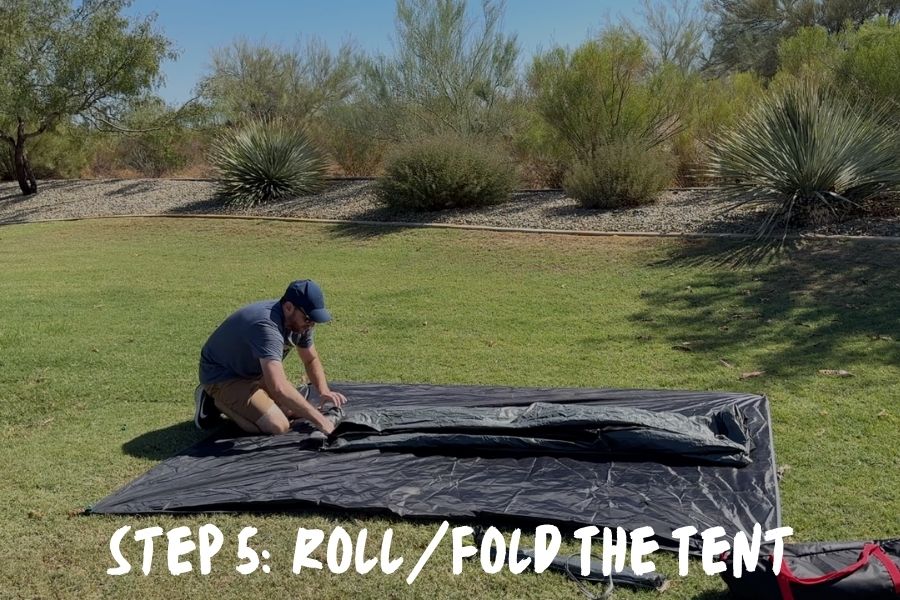
Time to fold! Now, there are two ways to do this: rolling or folding.
Each way has a use and a time. If you are backpacking or travelling, the easiest way to ensure your tent is compact and easy to carry is to roll your tent. Rolling the tent is always going to take up less room than folding it.
To do this, start with one end of the tent and gradually roll up the length of material, pausing to press out any remaining air as you go. If you’re packing your tent to travel, you can place your poles across the fabric and use them as the center anchor of your roll.
This makes it easier to roll and keep your tent gear all together.
When I roll up my tent, I use my knees to press out any remaining air by kneeling on the growing roll every couple of turns to push the air out. Be careful of doing this if you decide to use the pole method.
Folding your tent is great for long-term storage. It allows the tent fabric to have more breathability. So, if you’re packing your tent up for the season, folding it is a great option.
Though, you can also fold the tent for backpacking. It will just take up a bit more room in your pack.
The steps for folding are essentially the same. Once you have the fabric folded into that large strip, simply fold the fabric as you would a bath towel until you’re left with a neat square of fabric.
Step 6: Secure The Folded Tent
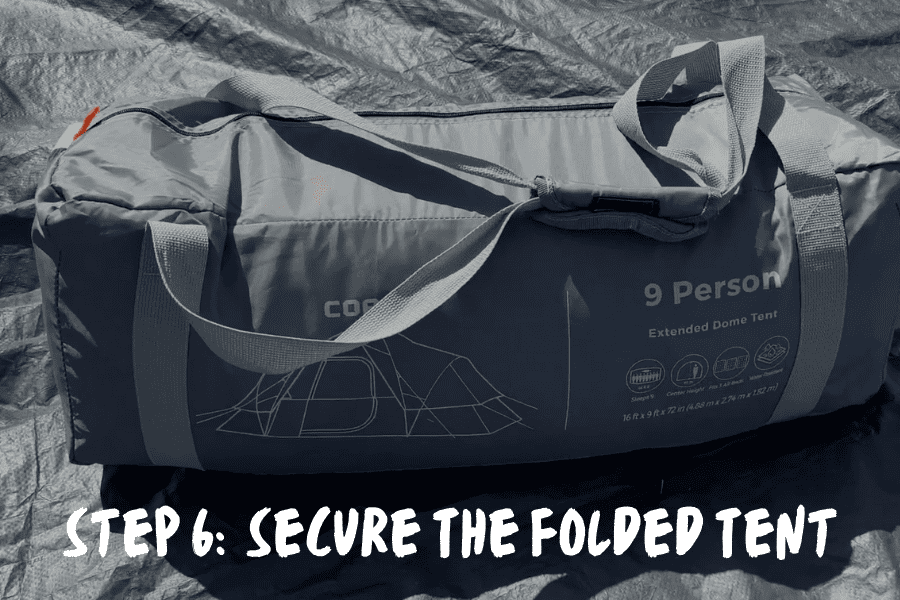
Once the tent is completely consolidated into its roll or square, you can secure it by placing it in its tent bag, or by using any remaining straps to keep the fabric together.
When I’m camping, I generally use my tent bag to keep my folded tent, stakes, and poles together.
Tips For Efficient Tent Folding
No matter what type of tent you have, it’s always important to prepare it properly before you start folding.
In addition to helping with the process itself, properly preparing your tent will also keep it in better condition for longer.
Pre-Folding Preparations
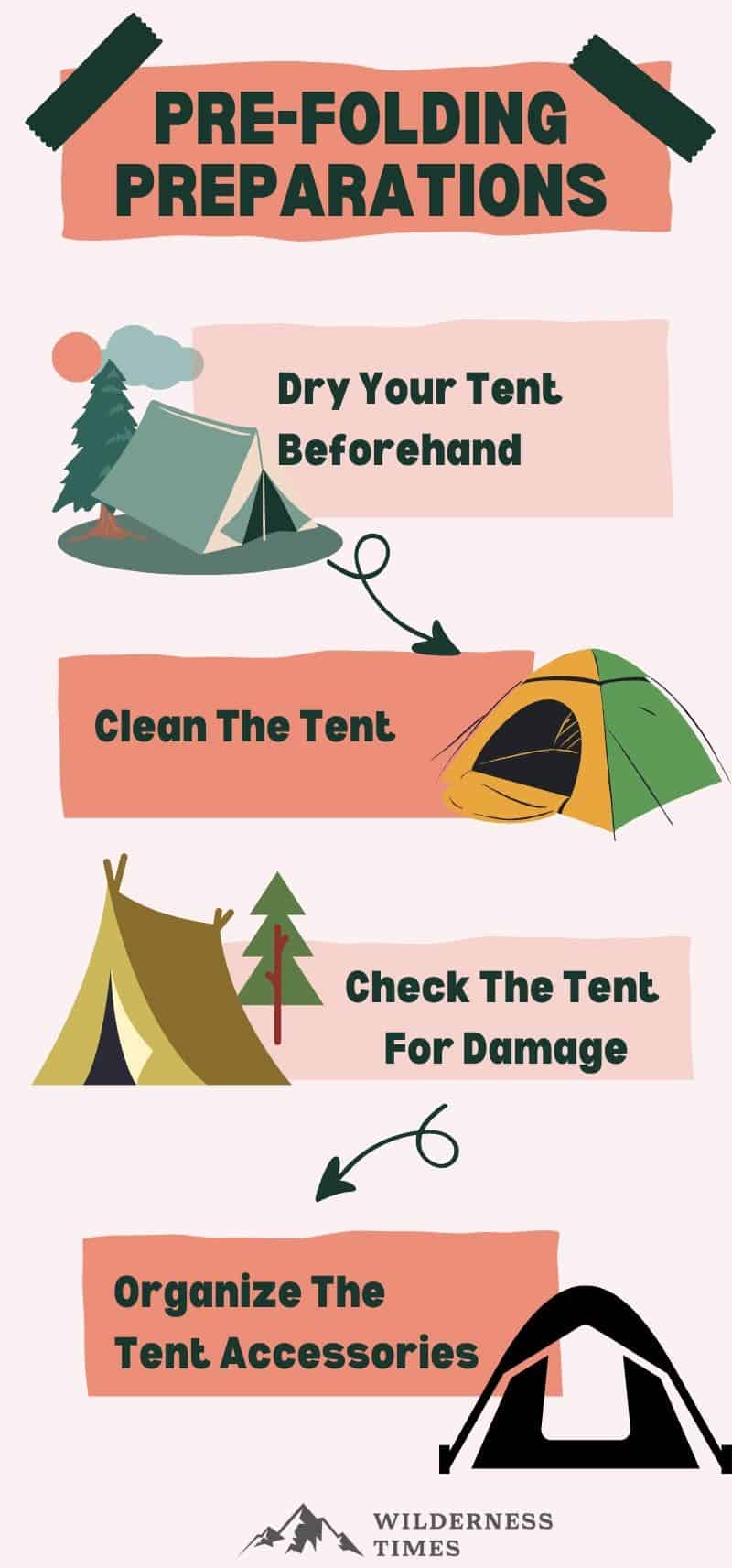
Dry Your Tent Beforehand
If possible, try to get your tent dry before folding it up.
If water is caught in the seams of your tent for a long period of time, it can lead to mold and mildew which will damage your tent.
However, I understand that it can be difficult to get your tent completely dry the morning of a campout, especially if there was a rainstorm the night before or dew that morning.
In cases where there’s unavoidable moisture on your tent, try to shake off as much water as possible before folding and, when you get to your campsite that night, prioritize setting up your tent so it can air out before you get into it.
Once you’re back home after your adventure, make sure you let your tent dry out completely before folding it up for storage.
Clean The Tent
Before you fold up your tent on the trail, make sure that you’ve brushed off as much dirt and dust as possible.
This is especially important if there’s any mud on the tent when folding, since it can easily get the rest of the tent and tent supplies dirty.
During this step, don’t worry too much about the regular amount of dirt you get on the tent from the general wear and tear of the trail.
You can get most of that off when you get home.
Instead, focus on getting rid of any large patches of dirt, mud, or debris before folding.
Check The Tent For Damage
It’s important to take a look at your tent for damage every few times you pack it up.
Checking along the zippers and seams for tears and functionality, or for any holes in the larger portions of fabric of a tent, can be really important in ensuring you can use it for another day!
Organize The Tent Accessories
Before I start any folding or rolling with a standard tent, I make it a point to know where all the tent accessories are located.
I find that it’s easiest to gather the stakes and poles as you take down the tent.
As you remove these items, make sure to put them in a consolidated place or bag.
Most tent companies will include bags for these items in the larger tent bag itself.
Once you have all of these items gathered together, it’s up to you to decide how to pack them.
Some campers like to place them in the tent bag before they fold up the tent, others like to include them in the actual roll of tent to keep everything consolidated.
Use Ground Tarps To Protect Your Tent While Camping
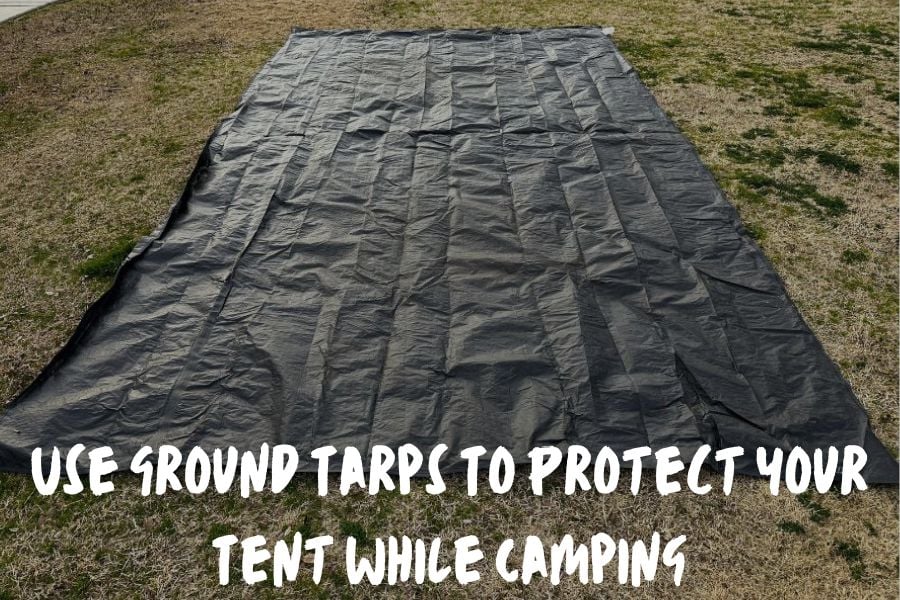
It’s important to make sure your tent stays fairly clean throughout your camping trip.
Enter ground tarps! These tarps can be laid directly on the ground to create a barrier between the ground and the bottom of your tent.
Simply lay out the ground tarp, pitch your tent on top of it, and secure all the pieces together when you stake down the tent.
Have A Partner Help You Fold Your Tent
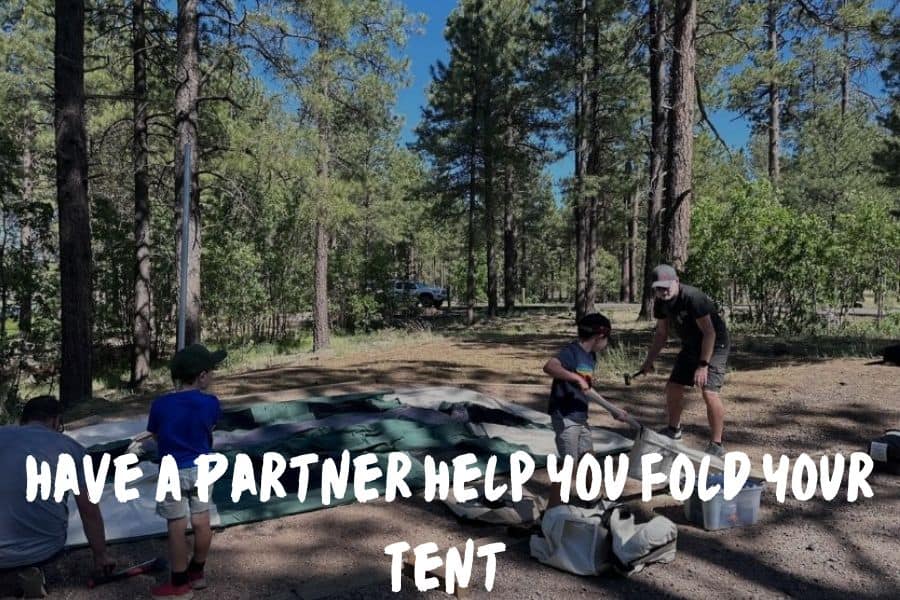
Because of the sheer amount of fabric, even the smaller 2-person tents can be difficult to fold on your own.
Folding with a partner can make the entire process much easier.
If you have two people folding a tent each person should grab a set of corners, one corner in each hand.
Then walk towards each other until the corners in your hands touch the corners in your partner’s hand.
From there, the tent will be a much more manageable size which you should be able to fold up much easier on your own.
If you’re on a solo camping trip, or don’t have a partner with you who can help you, you can always complete this first fold by folding the tent on the ground itself.
Once the tent is doubled on itself, you should be able to lift it off the ground and fold the rest of it up.
Store The Tent In A Cool, Dry Place
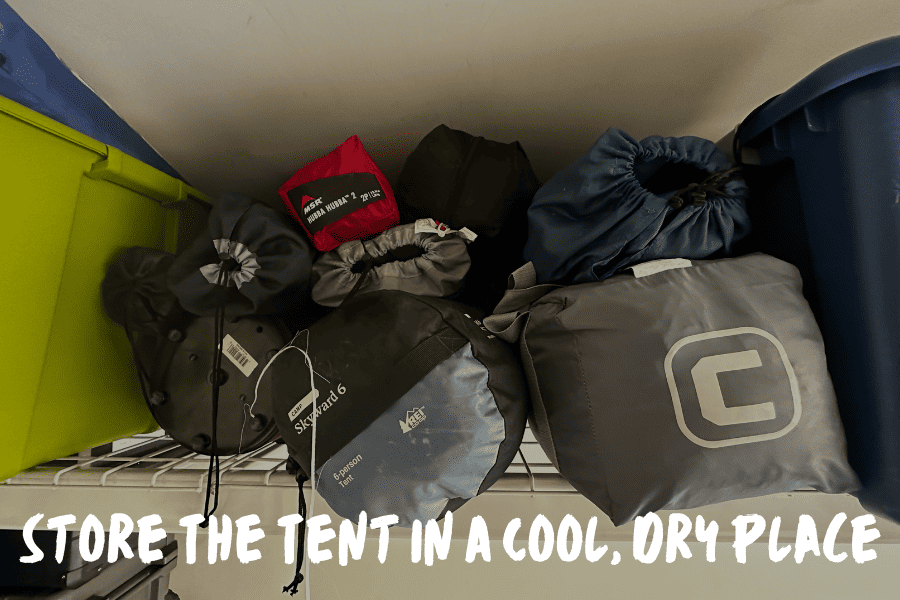
Folding a tent for long term storage is much different than folding a tent on the trail.
When you’re folding a tent on the trail, the goal is to make it as small as possible so it’s easier to carry.
This results in a fairly tight roll.
When you’re folding up a tent for long term storage the priority should be keeping it in good condition.
To do this, you’ll want to keep it loosely folded – instead of the tight fold you’ll do on the trail – in a cool, dry place
The looser fold will ensure that any excess moisture can escape the tent, reducing the likelihood of mold or mildew growth while in storage.
FAQs
Is It Better To Roll Or Fold A Tent?
For most standard tents, rolling will be a fundamental step in securing the tent’s fabric for packing away.
In these cases, you’ll want to fold up your tent to consolidate the fabric, then roll it all up.
For instant and pop-up tents, folding will be the way to go.
This is because these tents are packed up with the internal poles and structure included, meaning that rolling will be impossible.
Can I Fold The Tent With The Groundsheet Attached?
You can, although I don’t always recommend it.
Because groundsheets protect the bottom of your tent from the ground, they can get fairly dirty.
Rolling them up with the rest of the tent risks the dirt spreading to your tent, stakes, and poles.
Instead, shake out your ground tarp and fold it up on its own. Once it’s folded, you can store it on one side of your tent bag, or in a separate place entirely.
Can I Fold The Tent With The Poles Still Inside?
It depends! You should remove the poles from standard tents (i.e. tents with removable poles) before folding.
Other tents, like instant or popup tents, are designed to be folded with the poles remaining in the tent.
Always check the instructions to read the specific folding instructions relating to your tent before folding or rolling.
How Do I Prevent Mold Or Mildew When Storing My Folded Tent?
The best way to prevent mold or mildew from growing is to ensure your tent is completely dry before folding it up for storage.
Mold and mildew occur when there is leftover moisture stuck in the tent, especially near the seams and zipper.
When you get home from your campout, make sure you air out your tent for at least a few hours in a dry, warm spot.
This will ensure that all moisture evaporates from the inside of the tent.
When you’re folding your tent for storage, make sure to fold it loosely, rather than in a super tight roll.
The added space within the fold will ensure that any excess moisture can escape – and that the fabric doesn’t accumulate wear and tear from the tension of a tight roll.
Final Thoughts On Folding A Tent
Folding a tent can be a bit complicated, but hopefully this article makes it a little easier!
Once you master the techniques described above, you should be able to fold and pack away any tent you come across.
More:


